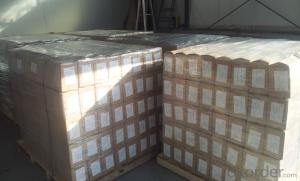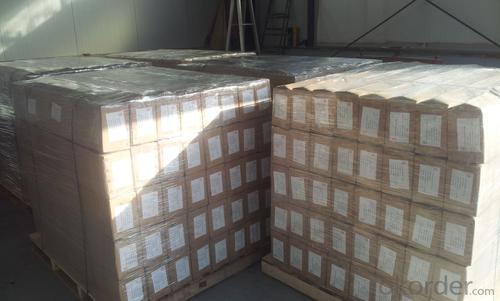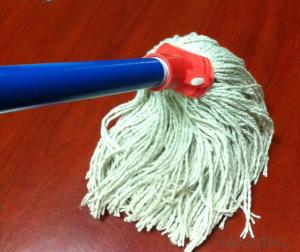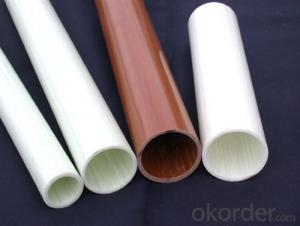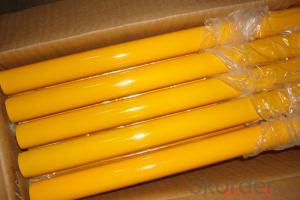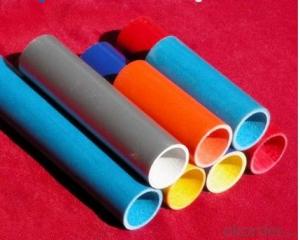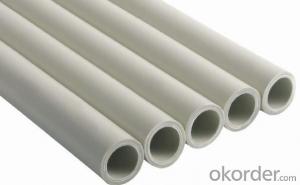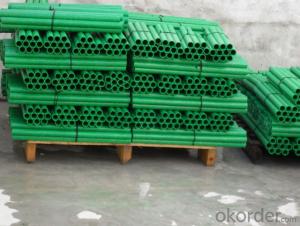FRP Pultrusion Profiles Fiberglass Broom Hand for Mop
- Loading Port:
- China Main Port
- Payment Terms:
- TT OR LC
- Min Order Qty:
- -
- Supply Capability:
- -
OKorder Service Pledge
OKorder Financial Service
You Might Also Like
Specifications of Fiberglass broom hand for Mop:
1.Corrosion resistant,lightweight, extremely strong and durable
2. Chemical proof, non-conductive
Advantages of Fiberglass broom hand for Mop:
Light weight, high strength— easier to transport and install with standard tools
Corrosion resistant— won’t rot or rust and absorbs minimal moisture
Chemical resistant-mild acid-alkali proof
Humidity resistant— no shrinking or swelling
Impact resistant — fiberglass mat distributes the load to prevent surface damage
Safety — won’t conduct electricity, and non-slip surfaces are available
Long-lasting— lower lifetime cost than traditional building materials
Low thermal conductivity — does not easily conduct heat or cold
Non-electrical conductivity, with non magnetic property
- Q: Are FRP pultrusion profiles resistant to hydrocarbons?
- Yes, FRP (Fiber Reinforced Polymer) pultrusion profiles are generally resistant to hydrocarbons due to their inherent corrosion resistance properties. The composite materials used in FRP profiles provide excellent resistance to various chemicals, including hydrocarbons, making them suitable for applications in industries where exposure to such substances is common.
- Q: How is FRP pultrusion different from other manufacturing processes?
- FRP pultrusion is different from other manufacturing processes in its unique method of producing fiber-reinforced polymer (FRP) profiles. Unlike traditional processes like extrusion or injection molding, pultrusion involves pulling continuous fibers through a resin bath and then into a heated die, where they are cured and shaped into the desired profile. This continuous and automated process allows for the production of strong, lightweight, and corrosion-resistant FRP profiles with consistent mechanical properties. Additionally, pultrusion enables the incorporation of various fiber orientations and resin systems, making it highly versatile for customized applications.
- Q: Are FRP pultrusion profiles resistant to electrical arcing?
- Yes, FRP pultrusion profiles are highly resistant to electrical arcing due to their non-conductive nature, making them a safe choice for applications where electrical arcing is a concern.
- Q: Can not use glass steel support column, the main support for the door
- The epoxy pultruded glass steel section is of high strength and can meet your requirement. You can choose the required section according to your requirement
- Q: Can FRP pultrusion profiles be used in chemical storage tanks?
- Yes, FRP pultrusion profiles can be used in chemical storage tanks. FRP (Fiber Reinforced Plastic) materials are known for their excellent corrosion resistance and durability, making them an ideal choice for storing various chemicals. The pultrusion process further enhances the strength and structural integrity of the profiles, making them suitable for demanding applications like chemical storage tanks.
- Q: What is the cost of FRP pultrusion profiles compared to other materials?
- The price of FRP pultrusion profiles can vary based on several factors, including the specific application, size, design complexity, and quantity needed. However, in general, FRP pultrusion profiles are often more cost-effective than many traditional materials. Compared to materials like steel, aluminum, or wood, FRP pultrusion profiles generally offer a lower overall cost, particularly when considering long-term savings. While the initial cost of FRP pultrusion profiles may be slightly higher than some traditional materials, the advantages it provides can outweigh the price difference. FRP pultrusion profiles are renowned for their lightweight nature, high strength-to-weight ratio, resistance to corrosion, and durability. These characteristics help reduce transportation expenses, installation costs, and maintenance needs. Furthermore, the long lifespan of FRP profiles ensures minimal repair or replacement costs over time. Additionally, the manufacturing process of FRP pultrusion profiles allows for precise customization, eliminating the necessity for extra machining or fabrication, which can further reduce expenses. Incorporating design features like integral stiffeners, brackets, and fastening points during the pultrusion process eliminates the need for additional assembly steps, ultimately saving time and money. It is important to acknowledge that although FRP pultrusion profiles may have a higher initial cost compared to some materials, their overall cost-effectiveness and long-term benefits make them a favorable choice in many applications. When evaluating the cost of FRP pultrusion profiles in contrast to other materials, one should consider the specific requirements and considerations of each project.
- Q: Can FRP pultrusion profiles be customized or tailored to specific project requirements?
- Yes, FRP (Fiber Reinforced Polymer) pultrusion profiles can be customized or tailored to specific project requirements. Pultrusion is a manufacturing process that allows for the creation of continuous fiber-reinforced composite profiles with a high level of design flexibility. The specific requirements of a project, such as dimensions, shapes, and mechanical properties, can be accommodated by adjusting the design and manufacturing parameters. The customization process begins with understanding the project's needs and specifications. This includes determining the desired profile dimensions, cross-sectional shape, and mechanical properties such as strength, stiffness, and durability. Based on these requirements, engineers and manufacturers can develop a tailored solution. The customization of FRP pultrusion profiles can be achieved through various means. Firstly, the choice of reinforcement materials, such as fiberglass, carbon fiber, or aramid fiber, can be selected based on the desired mechanical characteristics. The orientation and volume fraction of the fibers can also be adjusted to optimize the strength and stiffness of the profile. Additionally, the resin matrix used in the pultrusion process can be customized to enhance specific properties, such as fire resistance, chemical resistance, or UV resistance. Various resin systems, including polyester, vinyl ester, or epoxy, can be utilized to meet the project's requirements. Furthermore, the pultrusion process allows for the incorporation of additional features during manufacturing. This includes adding inserts, fastener holes, grooves, or other structural details to the profile. These modifications can be tailored to the specific project requirements, ensuring compatibility with the overall design and assembly. Overall, FRP pultrusion profiles offer a high degree of customization and tailoring to meet specific project requirements. This versatility makes them a popular choice in various industries, including construction, infrastructure, aerospace, and automotive, where lightweight, durable, and corrosion-resistant materials are needed.
- Q: Are FRP pultrusion profiles resistant to UV degradation?
- Yes, FRP pultrusion profiles are generally resistant to UV degradation. The combination of the materials used in pultrusion, such as fiberglass and resin, provides inherent UV resistance, making them suitable for outdoor applications where exposure to sunlight is a concern. However, it is always recommended to consult the manufacturer's specifications and guidelines to ensure optimal UV protection and longevity.
- Q: How do FRP pultrusion profiles perform in high humidity environments?
- FRP pultrusion profiles excel in environments with high humidity due to their exceptional performance. The inherent qualities of FRP, such as its resistance to corrosion and moisture, make it an ideal material for applications exposed to moisture or high levels of humidity. One major advantage of FRP pultrusion profiles is their non-porous nature, which means they do not absorb moisture. This characteristic prevents the profiles from swelling, warping, or deteriorating when exposed to high humidity. Unlike traditional materials like wood or steel, FRP does not degrade or lose its structural integrity in humid conditions. Furthermore, FRP pultrusion profiles have a high resistance to chemicals, including the corrosive effects of moisture and humidity. This corrosion resistance is a result of the composite nature of FRP, which combines a matrix material (typically a resin) with reinforcing fibers, such as glass or carbon fibers. This combination provides excellent resistance to water and moisture-induced corrosion, ensuring the long-term performance of FRP profiles in high humidity environments. Moreover, FRP pultrusion profiles exhibit excellent dimensional stability, even under extreme variations in temperature and humidity. They do not significantly expand or contract, maintaining their shape and structural integrity in diverse environmental conditions. This stability makes FRP profiles suitable for applications in coastal regions, wastewater treatment plants, chemical processing plants, and other environments with high humidity levels. In conclusion, FRP pultrusion profiles are specifically designed to withstand harsh conditions, including high humidity environments. Their non-porous nature, corrosion resistance, and dimensional stability make them a dependable and durable choice for various applications in humid climates.
- Q: Can FRP pultrusion profiles be used in the construction of playground equipment?
- Yes, FRP pultrusion profiles can be used in the construction of playground equipment. FRP (Fiber Reinforced Polymer) pultrusion profiles are known for their high strength-to-weight ratio, durability, and resistance to corrosion and weathering. These qualities make them suitable for various applications, including playground equipment, where safety and longevity are important factors. FRP pultrusion profiles can be used to construct slides, climbing structures, handrails, and other components of playground equipment, providing a safe and reliable solution for recreational areas.
Send your message to us
FRP Pultrusion Profiles Fiberglass Broom Hand for Mop
- Loading Port:
- China Main Port
- Payment Terms:
- TT OR LC
- Min Order Qty:
- -
- Supply Capability:
- -
OKorder Service Pledge
OKorder Financial Service
Similar products
Hot products
Hot Searches
Related keywords
